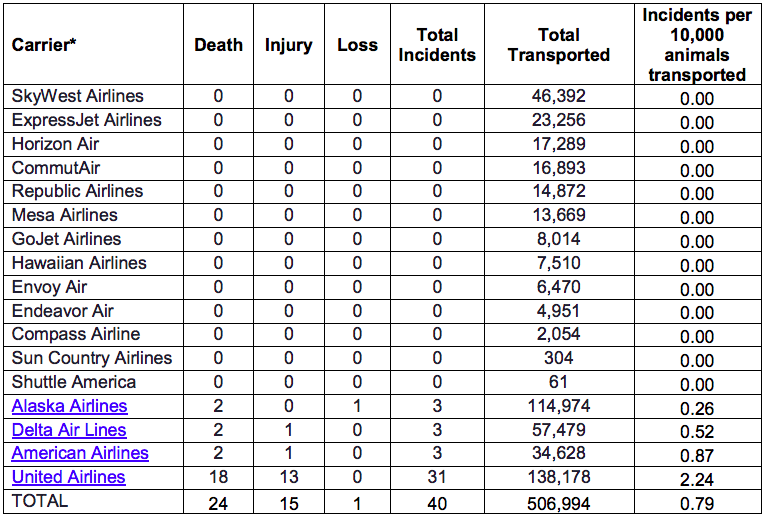United Airlines has a track record of more animal deaths than other airlines
United Airlines (UAL) has a track record of reporting more dead animals than its peers.
Since 2012, there have been 153 animal deaths on airlines in the U.S. Of those, United accounted for 66 of them, or 43%, according to an analysis of Department of Transportation (DOT) filings reviewed by Yahoo Finance. To be fair, United also transports more animals than the other airlines.
This week, a United passenger’s 10-month old French bulldog died in its carrier after a flight attendant had it placed in an overhead compartment. The airline apologized and said it would take full responsibility.
More than 500,000 pets travel on airplanes in the U.S. every year, according to the DOT data. For the most part, incidents are rare. That said, flying can be risky, especially for certain kind of breeds.

REUTERS/Kim Kyung-Hoon“Air travel can be particularly dangerous for animals with ‘pushed in’ faces (the medical term is ‘brachycephalic’), such as bulldogs, pugs and Persian cats. Their short nasal passages leave them especially vulnerable to oxygen deprivation and heat stroke,” the Humane Society’s website states.
Airlines in the U.S. are required by the DOT to report “loss, injury or death of an animal during air transport provided by an air carrier.” In 2017, approximately 506,994 animals were transported by airlines, with a rate of 0.79 incidents per 10,000 animals. A total of 24 animals died, while 15 were injured, and one animal lost, for a total of 40 animal incidents, the DOT data shows.

Of those reported incidents, United was at the top with most incidents, reporting 18 deaths and 13 injuries.
Last year, 138,178 animals flew with United, with an incident rate of 2.24 per 10,000 animals transported. Again, United transports about 27% of all animal flights, which could increase the likelihood of an incident.
“We are very liberal in our reporting in terms of what we consider an injury,” Charlie Hobart, a spokesperson for United, told Yahoo Finance. “When we see a dog that has a little toenail that might be chipped, or there’s a drop or two of blood, we consider that an injury.”
Hobart added that United does not know if competitors take the same approach to reporting incidents.
United also features safety tips on its website for customers traveling with pets.
An examination of the reported incidents shows that in most cases no corrective action was taken by United since the deaths were considered from natural causes or a necropsy wasn’t performed, the filing shows. One exception was when a three-year-old Abyssinian named Riko escaped its shipping container during the acceptance process and was hit by a car. United said that it would “review existing procedures to enhance [the] security of animals during acceptance process.”
In another instance, a four-year-old Cavalier King Charles Spaniel named Lulu was found dead upon arriving in San Francisco. A medical exam attributed Lulu’s death to heat stroke. The airline noted that two other animals onboard were found healthy upon arrival in San Francisco and no corrective action was taken.
Some of the animals died of natural causes, including a 9-year-old cat named Hope that had heart failure and a dog named Rocco that died of a cardiac abnormality due to congenital heart disease. Other deaths, including two geckos on a flight to Raleigh, didn’t have medical exams performed.
Meanwhile, American Airlines (AAL) ranked No. 2 for the most incidents in 2017, reporting two deaths, including a golden retriever and a German shepherd and an injured poodle. American Airlines transported 34,628 animals for a rate of 0.87 incidents per 10,000 animals transported.
Delta (DAL) disclosed two deaths and one injury of the 57,479 animals it flew in 2017. The airline had a rate of 0.52 incidents per 10,000 animals. One of those reported deaths was a kitten that had a pre-existing medical condition and an Aussie shepherd puppy that died from acute myocardial necrosis.
Alaska Airlines (ALK) flew 114,974 animals in 2017, reporting two deaths and one missing animal for an incident rate of 0.26 for every 10,000 animals. The lost pet was a cat named Gaige that escaped its kennel at the Honolulu International Airport. It still has not been found.
Hawaiian Airlines (HA) posted 0 incidents in 2017. However, in 2016, Hawaiian Airlines had a higher rate of events than other airlines, of 3.99 per 10,000 animals. The carrier flew 7,518 animals and reported three deaths in 2016.
Hawaiian Airlines refunded the pet and cargo fees for the owners. The airline also paid for a necropsy and cremation for a deceased bulldog named Jax.
Julia La Roche is a finance reporter at Yahoo Finance. Follow her on Twitter.

 Yahoo Finance
Yahoo Finance 
